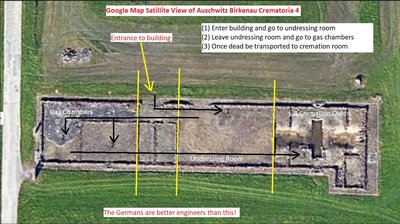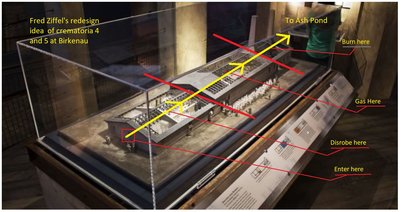The article by Franciszek Piper that was quoted by Wikipedia also says that Mengele acted as a "supervising doctor" for gassings in crematoria II and III (
https://archive.org/details/anatomyofauschwi00yisr /
https://libgen.lc/index.php?req=anatomy+auschwitz+death+camp):
> The extermination process and cremation of the corpses in crematoria II and III went as follows. After selection for death, the Jews who could walk were marched from the loading ramp to the crematorium. The weak, the invalid, and the sick were transported on trucks. In the crematorium yard, the SS men told the prisoners that they would undergo a disinfection that consisted of delousing and bathing. The victims were led down the staircase to the dressing room in the basement, where they could see the signs (in German) "To the Baths" and "To Disinfection." Similar signs were posted on a portable board in the native language of the victims.
> On the way to the gas chamber some victims were issued a piece of soap and a towel. As a rule, the women and children went in first, followed by the men. Each group was led inside the chamber behind a cordon of SS men that edged toward the door as the chamber filled. With the refractory ones spurred on by blows and dogs, about 2,000 persons on average were crammed inside.
> When the chamber was full or the entire transport was inside and the personnel had left (two SS noncommissioned officers always stayed until the end), the doors were shut, the bolts were slid into place, and the screws were tightened. On order of the supervising SS doctor (the job was assigned to, among others, Josef Mengele, Hans Kénig, and Hans Thilo), the SS disinfectors (Scheinmetz, among others) opened the Zyklon B cans and poured their contents into the vents down the induction shafts inside the chamber.
> [...]
> In the killing process at crematoria IV and V, the prisoners were also brought in cars or were marched to the crematoria, then led to the dressing room. There one of the SS men - the Kommandoführer - would stand on a bench in front of them and explain that the healthy would go to work and the sick and the women and children would remain in the barracks. But first, they would go to the bath.
> After undressing, the prisoners were led through the anteroom to the gas chamber. When the chamber was full, the SS guards shut the doors, and one of them, wearing a gas mask, climbed a ladder or a chair. When the SS doctor on duty gave a sign, the SS man would pour Zyklon B pellets into the opening. In the summer of 1944, Mengele served most often as the duty doctor in crematoria IV and V, and Kommandoführer Scheinmetz, who supervised the Sonderkommando work in crematorium V, poured the pellets.
By googling for `"scheinmetz" "mengele" "iv"`, I found that the story that Mengele oversaw the gassings in Krema IV and V may have come from the testimony of Shlomo Dragon (who is called Szlama Dragan in other sources) (
https://www.auschwitz.org/en/museum/news/a-new-auschwitz-discovery,420.html):
> Extracts from a deposition by the witness Shlomo Dragon, Auschwitz prisoner number 80359. On May 10-11, 1945, he testified as follows to the murder of people in the gas chambers and the burning of their corpses:
> Gassing:
> When the chamber was full, the door was closed. This was done by SS guards and usually by Moll himself. Then Mengele gave an order to Scheinmetz who, just as he did at the bunkers, went over to a vehicle with the sign of the red cross on it, took out a canister of gas, opened it, and poured its contents into the chamber through the little window in the side wall. The little window was fairly high up, so he had to use a step-ladder to get to it. Here, just as at the bunkers, he was wearing a mask when he did it.
> Extracting teeth and cutting off hair:
> After a certain time, Mengele communicated that the people were dead. He said, "Es ist schon fertig," and drove away with Scheinmetz in the vehicle with the red cross. Then Moll opened the door of the gas chamber. We put on gas masks and dragged the corpses out of the different chambers, through the little corridor to the undressing room, and through the dressing room and then through the little corridor to the furnaces. Barbers sheared their heads in the first corridor, at the entrance door, and dentists pulled teeth in the second corridor.
An article by Pressac from 1982 titled "Les «Krématorien» IV et V de Birkenau et leurs chambres à gaz" mentions that some parts of Szlama Dragan's testimony referred to Krema IV and V (but it's not clear if Mengele was also supposed to have overseen the gassings at Krema IV and V) (
https://www.cairn.info/revue-le-monde-juif-1982-3-page-91.htm, machine-translated from French):
> Szlama Dragan - tragic forced actor - stands facing the cremation room ramp under the fires of the massive eight-retort furnace. He speaks of the ardent summer of 44 (3, appendix 17): "... after the railway junction leading from the Auschwitz station to Birkenau was started, the men were, as soon as they got off the wagons, pushed pace towards crematoria IV and V. The detainees who arrived returned to the room where they had to undress [large hall]. Gorger [Kommandoführer/commando leader] pressed them saying: "Hurry, otherwise the meal and the coffee will be cold". The men were asking for water. Gorger said: "The water is cold, it is forbidden to drink it, hurry up, you will have tea when you get out of the bath" [emphasis added]. When all the detainees were gathered in the room where they undressed, Moll [Otto Moll, Hauptscharführer/chief warrant officer, head of the Birkenau crematoria] climbed up on a bench and said to them: "In this camp the able-bodied will go to work, the women and the sick will remain in the blocks". And pointing to the buildings of Birkenau, he added that before going there, everyone had to take a bath [idem, above] otherwise the camp authorities would not allow them to enter. When all the detainees were undressed, they were quickly led to the gas chamber[s]. At the beginning there were only three gas chambers, then a fourth was built there. The capacity of the first was 1,500 people, the second 800, the third 600 and the fourth 150. The men passed from the room [large hall] where they undressed through a small corridor [Vorraum/vestibule] to the gas chamber. In the gas chambers, there were signs: "Zur Desinfektion/A la disinfection" [and not: "Zum Baden/Aux Bains"]. The SS guards, and most often Moll himself, closed the door when the gas chambers were full. Then, Mengele [SS doctor at the rank of Hauptsturmführer/captain, famous for his "research" twins] ordered Scheinmetz [SS-Rottenführer/master corporal] to fetch the boxes of gas [18].
> It was then that we removed the stretcher and closed the mouth of the oven. We would then load another oven. Burning lasted 15 to 20 minutes. This finished, the ovens were loaded again. When the convoys of Hungarians arrived we worked in two shifts (...). The day shift from 6:30 a.m. to 6:30 p.m., the night shift from 6:30 p.m. to 6:30 a.m. This lasted about 3 months. The performance of the crematoria having then proved insufficient, three large and two smaller pits were dug next to crematorium V in order to burn the corpses of the gassed Hungarians". By condensing the sequence of operations, they can be summarized as follows: the selected unfitfrom the ramp were taken to the cloakroom (large hall), undressed there, then were directed to the gas chambers, and died there. The Sonderkommando evacuated the corpses by dragging them into the antechamber, then along the entire length of the locker room, through the airlock to finally reach the oven room. Industrially, the course of operations is aberrant. If the crematoria had been scrupulously planned to exterminate in a chain, only the logical succession of undressing/gassing/cremation would have been retained and not the gassing/undressing/cremation arrangement. Moreover when Dragan completes 17-545 (3, appendix 17): "A man of average height could, arms outstretched, reach the edge of the small window through which the contents of the boxes of Zyklon were thrown. Scheinmetz climbed up a small ladder outside to open the window and throw Zyklon into it", thus repeating his testimony of 10 and 11-5-45: "the gas canister... to pour the contents into the gas chamber through the small window placed on the side wall. To reach it, Scheinmetz, wearing a mask, climbed a ladder", we are amazed in front of this DIY, when it would have been so simple to place or equip the openings otherwise, lower, or by building just below a small staircase of a few steps, so as to make them directly accessible. The witness recounts what he saw with his own eyes and what was happening: a spectacle leading to the death of those who had had the misfortune to appear there. So, one thing is obvious: KREMATORIUM IV AND V WERE NOT DESIGNED AS CRIMINAL INSTRUMENTS, BUT WERE TRANSFORMED FOR THIS PURPOSE [24].
In Pressac's book "Auschwitz: Technique and operation of the gas chambers", he quoted the testimony of Henrik Tauber who said: "They told me that I was not among the first to do this work, and that before I came another 2 million people had already been gassed in Bunkers 1 and 2 and Krematorium 1. Adding up, the total number of people gassed in Auschwitz amounted to about 4 million." (
https://www.historiography-project.com/books/pressac-auschwitz/501.php) After that, Pressac included the following comment: "A propaganda figure, become symbolic. We find the same type of response in the deposition by Szlama Dragan on 17th May 1945. where he says in similar terms: 'I am unable to say the exact number of Jews of other origin gassed at Auschwitz (except for 70,000 Greek Jews burned in 1943). I think the total number gassed in the two Bunkers and the four Krematorien exceeded 4 million.'" However in Pressac's French article from 1982, he seemed to accept other parts of Dragan's testimony at face value.
According to an article written by Shlomo's brother Abraham, Shlomo Dragon is supposed to have escaped a death march together with Tauber (and the Sonderkommando are actually supposed to have buried their secret manuscripts in Krema III lol) (
http://www.tenhumbergreinhard.de/19331945opfer/1933-1945-opfer-d/dragon-shlomo.html):
> Shlomo managed to escape on the death march near Pszczyna together with the special detachment inmate Henryk Tauber. He reported to the Soviet investigative commission as an eyewitness and in February 1945 led its members to crematorium no. III, where members of the special commando had buried their "secret manuscripts".






